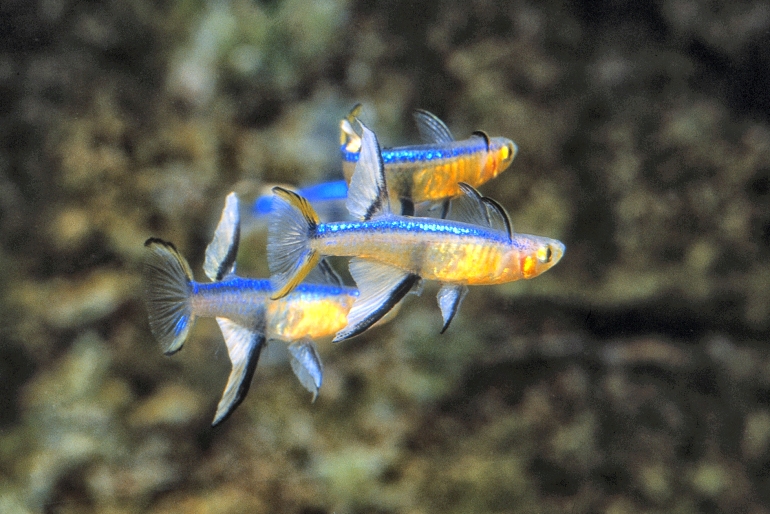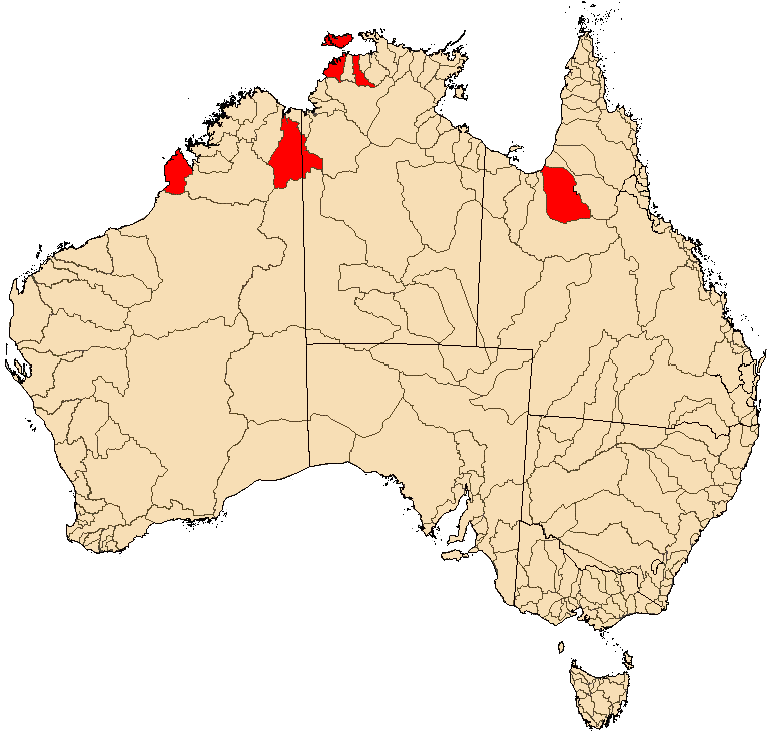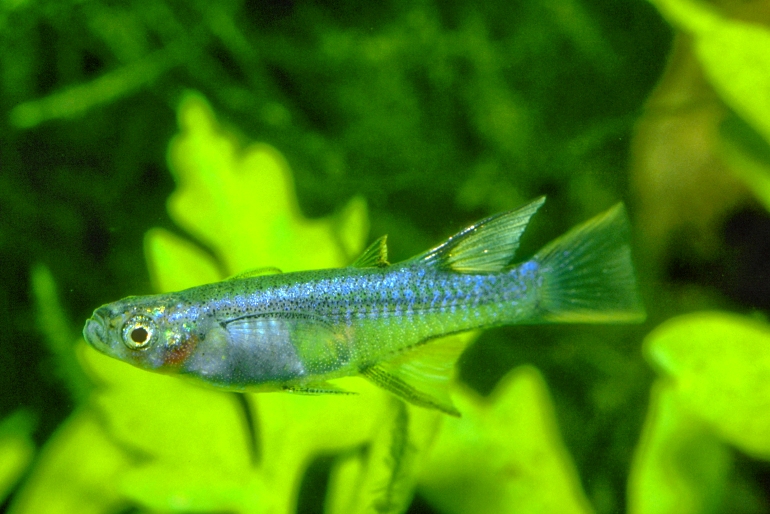|
 |
Pseudomugil cyanodorsalis - photo© Gunther Schmida |
Allen and Sarti, 1983
Neon Blue Eye
Species Summary
Pseudomugil cyanodorsalis is a very colourful species and deserves a much better common name than 'Blueback Blue Eye' as suggested by Gerald Allen. The upper half of the males' body is metallic blue (similar to the Neon Tetra) and peppered with fine grainy melanophores. The lower half of the males' body is translucent to yellowish white. A single thin dark mid-lateral line runs from the base of the pectoral fin to the caudal fin. The first dorsal fin is translucent with an outer blackish border, and a small yellowish patch at the base near the last spine. The elongated anterior rays and outer edge of the second dorsal and anal fins are black. The remainder of the fin is creamy yellow or whitish. The caudal and pectoral fins are translucent or slightly yellowish with black outer edges. The body of the female is a semi-transparent silver-grey colour with translucent fins and white abdomen. Maximum size is around 3.5 cm. Pseudomugil cyanodorsalis were originally available in the Australian hobby in 1982 but failed to become established. Another wild-collection for the aquarium hobby was made in 1986 and today, they are widely distributed in the aquarium hobby all around the world.
 |
Distribution Map
(Absence from other catchments may reflect a lack of sampling rather than non-existence.) |
Distribution & Habitat
Pseudomugil cyanodorsalis was first collected by Helen Larson (Northern Territory Museum) in 1981 near Darwin. A year later Gerald Allen (Western Australian Museum) found them in Crab Creek, 15 km east of Broome in Western Australia. In 1983, there were scientifically described by Allen and Sarti. They have been collected from around Broom and Wyndham in northern Western Australia. In the Northern Territory they have been recorded in coastal catchments around Darwin and the Mary River. They have also been collected from Melville Island. In Queensland they have been collected from the Norman River in the Gulf of Carpentaria. They are probably widely distributed in estuarine and coastal freshwater habitats across northern Australia and southern New Guinea. Pseudomugil cyanodorsalis are sympatric with Pseudomugil inconspicuus, and are found together in at least one locality (Woods Inlet) near Darwin.
Pseudomugil cyanodorsalis are euryhaline and tolerate a wide range of ecological conditions. Although more commonly found in small brackish estuarine creeks, they also inhabit pure freshwater habitats, especially during the wet season. During the wet season, freshwater flowing into these habitats dilutes the waters to fresh. Water thus varies from saline through brackish to fresh. However, habitat preference appears to be mangrove-lined muddy brackish creeks, where they are commonly found in large numbers. They have been found in hypersaline waters (28-40 ppt) and at temperatures of 22-39°C.
 |
Pseudomugil cyanodorsalis - photo© Neil Armstrong |
Keeping & Caring
I first obtained wild-caught specimens of Pseudomugil cyanodorsalis in November 1982, but unfortunately they all died before I was able to breed them. I obtained further aquarium bred specimens in 1988 and succeeded in spawning them. Although they are most often found in brackish mangrove areas, I successfully bred and raised the fry in both brackish and fresh water over a period of three years. I had no problems keeping and breeding them under the following water conditions: temperature 21-27°C, pH 7.1-8.5, conductivity 227-560 µS/cm, TDS 230-290 ppm and hardness 130-140 ppm. Most spawning activity was recorded at a temperature range of 25-27°C; pH 7.7 - 8.5 and conductivity 265-560 µS/cm. Many hobbyists, however, report that they will live longer, breed more freely, and produce more offspring if maintained in brackish water. 25-50% seawater made up with one of the commercially available salt mixes should suit them fine.
In their natural habitat Pseudomugil cyanodorsalis are essentially seasonal breeding fishes usually spawning during October to December. In captivity they will breed at any time of the year if maintained under the right conditions. However, it is a good idea to rest the females between spawning events. Group spawning with multiple males and females is probably the preferred method for breeding. Spawning pairs is possible but group spawning should provide you with more eggs. Males' display with their dorsal and anal fins raised while actively pursuing a female. During this procedure the colour intensifies in both sexes. Non-receptive females will move away and swim to the surface or hide amongst the aquatic plants or spawning mops, remaining motionless to avoid detection. Eggs have adhesive filaments and are scattered among aquatic plants or the strands of the spawning mops, and sometimes even in the substrate. Eggs take around 12-15 days to hatch, depending on water temperature and conditions.
Pseudomugil cyanodorsalis are essentially a carnivore, feeding on a variety of terrestrial and aquatic insects, insect larvae, and small aquatic crustaceans. In captivity, they can be fed live or frozen foods such as daphnia, copepods, mosquito larvae or brine shrimp. Whiteworms and other small worms are also an excellent food. Flake food or small bite-sized pellets can be fed. However, for best results some supplementary feeding with live or frozen food is required.
.jpg) |
Pseudomugil cyanodorsalis (Buffalo Creek, NT) - photo© Dave Wilson |
Literature
Allen G.R. and N. Sarti (1983) Pseudomugil cyanodorsalis, une nouvelle espèce de blue-eye (Melanotaeniidae) d'Australie nord-occidentale. Revue française d'Aquariologie 10(2): 47-50.
Allen G.R. (1989) Freshwater fishes of Australia. T.F.H. Publications, Inc., Neptune City, New Jersey.
Allen G.R. (1995) Rainbowfishes in Nature and in the Aquarium. (Tetra-Verlag: Germany)
Allen G.R., S.H. Midgley and M. Allen (2002) Field guide to the freshwater fishes of Australia. Western Australian Museum, Perth, Western Australia.
Fukada M. (1998) Pseudomugil cyanodorsalis. ANGFA Bulletin 39:10-11.
Hansen B. (1990) Pseudomugil cyanodorsalis. Fishes of Sahul 6(1): 249-252.
Adrian R. Tappin
Updated October, 2015



|

